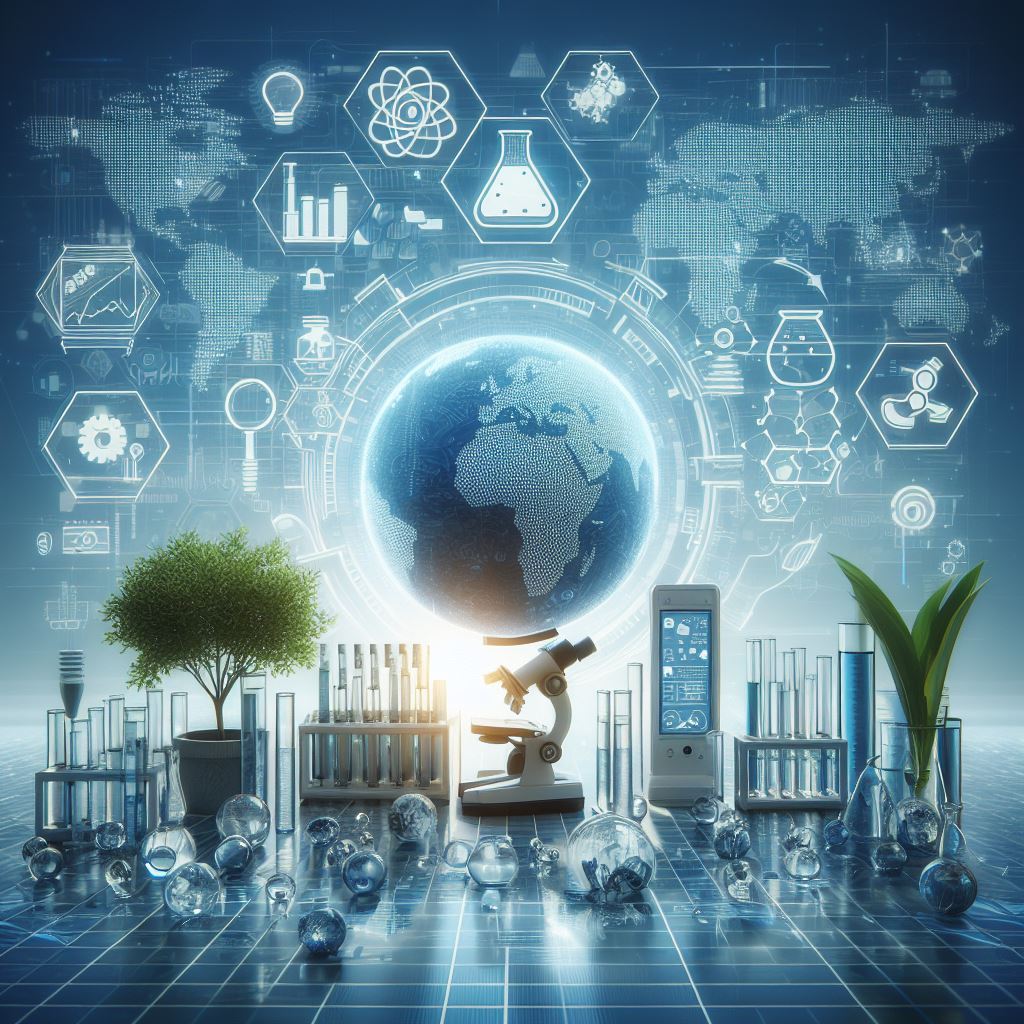Construction of digital laboratories for environmental testing institutions: with the help of science and technology, we will create a green future
Released:2024-01-26
Today, with the rapid development of science and technology, digital laboratories have become the core strength of environmental protection testing institutions. It not only improves the efficiency and accuracy of detection, but also provides more accurate data support for environmental protection.

1. The significance of the construction of the digital laboratory
1. Improve inspection efficiency:Traditional laboratory testing often requires a lot of manual operation, but digital technology can automate the processing of data, greatly shorten the testing cycle and improve work efficiency.
2. Enhance data accuracy:The high precision and stability of the digital equipment can greatly reduce human error compared to traditional methods, ensuring more accurate and reliable inspection results.
3. Facilitate data sharing and analysis:Through digital technology, the laboratory can realize real-time data sharing, which is convenient for multiple departments to work together. This not only improves work efficiency, but also provides more accurate data to support environmental decision-making.
2. The core elements of the digital laboratory
1. Advanced equipment:In order to achieve efficient detection and analysis, it is essential to introduce a series of high-precision testing instruments and automation equipment. For example, mass spectrometers, spectrometers, chromatographs, etc., which can quickly and accurately determine various environmental pollutants.
2. Information system:Establish a laboratory information management system (LIMS) that enables automatic data acquisition, storage, analysis, and report generation. This not only greatly improves work efficiency, but also ensures the accuracy and reliability of the data.
3. Professionals:While digital technology can greatly improve work efficiency, laboratory personnel with specialized knowledge and skills are still required for operation and maintenance. Therefore, it is crucial to develop a team with digital knowledge and skills.
4. Safety and quality control:The construction of digital laboratories also needs to pay attention to safety and quality control. Establish a sound safety management system and quality control system to ensure that all activities of the laboratory comply with relevant regulations and standards.
5. Data management and decision support:In addition to basic detection and analysis capabilities, a digital lab should have robust data management and decision support capabilities. Through data mining and analysis, potential environmental problems can be identified and scientific basis for decision-making.
6. Continuous improvement and innovation:With the continuous advancement of technology, environmental testing institutions should continue to pay attention to new digital technologies and methods, update and upgrade laboratory equipment and technologies in a timely manner, and maintain their leading position. At the same time, we encourage innovation and explore new application fields to make greater contributions to the cause of environmental protection.
7. Cross-departmental cooperation and communication:Strengthen cooperation and exchanges with other environmental protection institutions, research institutions and universities, and jointly discuss the application and development trend of digital technology in the field of environmental protection. By sharing experiences and resources, we can promote each other's development and drive the progress of the entire industry.
8. Social Responsibility and Public Participation:As an important force to protect environmental quality, environmental testing institutions should actively fulfill their social responsibilities and strengthen communication and interaction with the public. Enhance public awareness and participation in environmental protection by disclosing the progress and results of the laboratory. At the same time, it actively responds to social concerns and provides scientific basis and technical support for solving environmental problems.
9. Training and capacity building:In order to improve the skills and knowledge of employees in digital experimentation, relevant training and capacity building activities are carried out on a regular basis. This includes training in the use of new equipment, data processing and analysis, information security, etc., to ensure that employees are proficient in digital technology and can be applied to the real world.
10. Evaluation and continuous improvement:Establish an effective evaluation mechanism to regularly evaluate and review the operation of the digital laboratory. By collecting feedback, analyzing problems and shortcomings, and formulating corresponding improvement measures and plans, we will continuously improve and optimize the digital construction of the laboratory.
3. Practical application and effect
As a key tool for digital transformation, the LIMS system realizes the centralized management of experimental data. Establish a unified data storage platform to facilitate laboratory personnel to quickly access and share experimental data. By centrally managing experimental data, data silos are eliminated and data consistency and accuracy are improved. At the same time, the risk of data loss is reduced and data security is improved. Through the construction and application of digital laboratories, environmental testing institutions can better respond to various environmental problems. For example, it detects toxic substances in water, pollutants such as PM2.5 and ozone in the air, and heavy metals in the soil. At the same time, digital technology can also help testing institutions respond to environmental emergencies more quickly, and provide timely and accurate testing data and analysis reports for governments and enterprises. This will not only contribute to the smooth development of environmental protection work, but also provide strong support for economic development.
IV. Conclusion
The construction of digital laboratories for environmental testing institutions is an inevitable trend of the development of the times. With the power of science and technology, we will continuously improve the efficiency and accuracy of detection and contribute to the green future of the earth. At the same time, strengthen cooperation and exchanges, and jointly explore new directions for the application and development of digital technology in the field of environmental protection.
Related
Construction of digital laboratories for environmental testing institutions: with the help of science and technology, we will create a green future
Today, with the rapid development of science and technology, digital laboratories have become the core strength of environmental protection testing institutions. It not only improves the efficiency and accuracy of detection, but also provides more accurate data support for environmental protection.
Digitalization Drives Innovation: Exploring the Digital Transformation of New Energy Battery Manufacturing Enterprise Laboratories
With the rapid development of science and technology, digital transformation has become an important driving force for innovation and development in all walks of life. As an important pillar of green energy in today's world, the new energy battery manufacturing industry is facing unprecedented opportunities and challenges. The practice and application of digital transformation in new energy battery manufacturing enterprises is of great significance to enhance the core competitiveness of enterprises and promote the sustainable development of the industry.
Policy interpretation of the "Guiding Opinions on Promoting the Improvement of Enterprises' Measurement Capabilities".
In recent years, various competent authorities have issued many policies to encourage enterprises to improve their measurement management capabilities, such as the State Administration for Market Regulation and the Ministry of Industry and Information Technology jointly issued the "Guiding Opinions on Promoting the Improvement of Enterprises' Measurement Capabilities". The document proposes a number of measures, including strengthening the accumulation and application of enterprise measurement data, and building an enterprise measurement technology innovation ecology. Under the guidance of this important document, the company will usher in a clearer development direction in strengthening the construction of the measurement management system. This article will interpret the key provisions of the Guiding Opinions on the basis of them in combination with the policy guidance emphasized therein.
Pain points and LIMS solutions for rail transit testing institutions
With the advancement of science and technology and the implementation of digital policies, the rail transit industry is facing unprecedented challenges and opportunities. Especially in the field of equipment measurement management, the traditional model can no longer meet the needs of modern enterprises. In response to this trend, more and more rail transit companies are looking for innovative solutions. This paper will discuss the application of digital solutions in the management of metrology equipment in rail transit enterprises, and focus on the value and implementation of laboratory information management system (LIMS).
How to realize the integration of business and laboratory informatization of third-party testing laboratories
With the advancement of science and technology and the continuous development of global trade, third-party testing laboratories play an increasingly important role in ensuring product quality and safeguarding consumer rights. In this context, how to realize the integration of business and laboratory informatization and further improve the efficiency and accuracy of testing has become a problem worth exploring.
How to choose a laboratory management system (LIMS) for food processing enterprises
With the rapid development of the food processing industry, the demand for laboratory management systems is also increasing. Laboratory management systems (LIMS) are an indispensable part of food processing companies as they can effectively improve the efficiency and accuracy of laboratories and reduce costs. However, how to choose the right LIMS system for your business?










